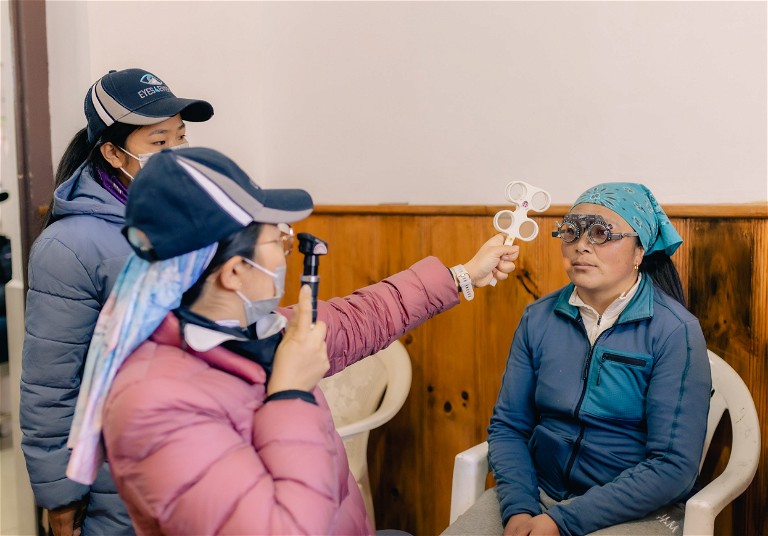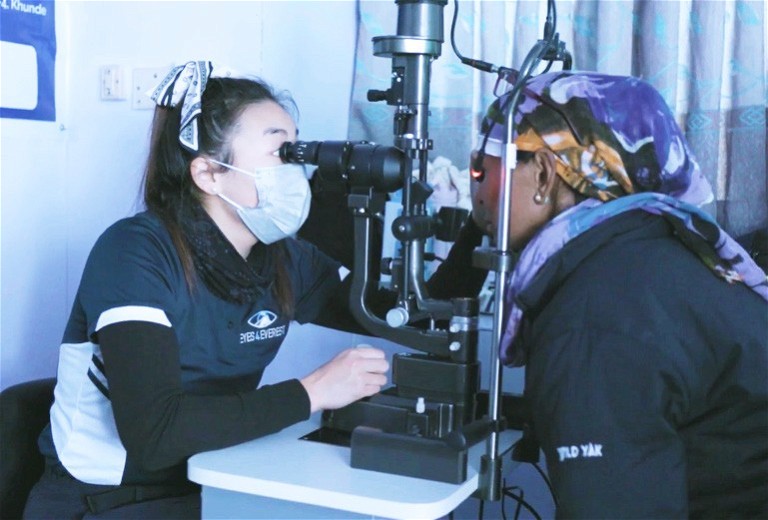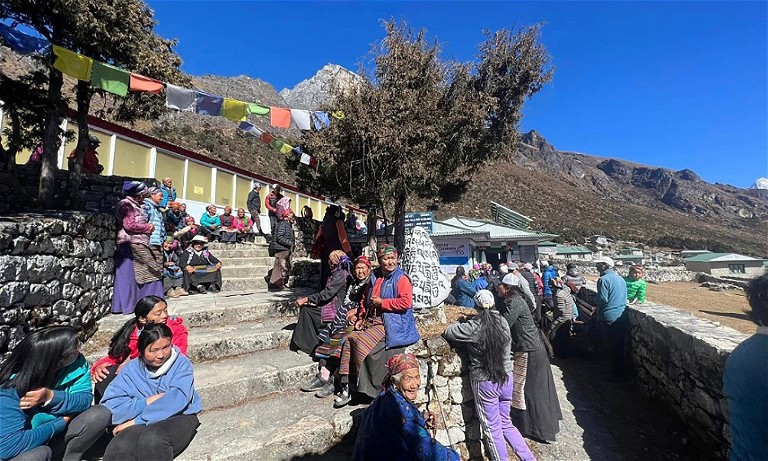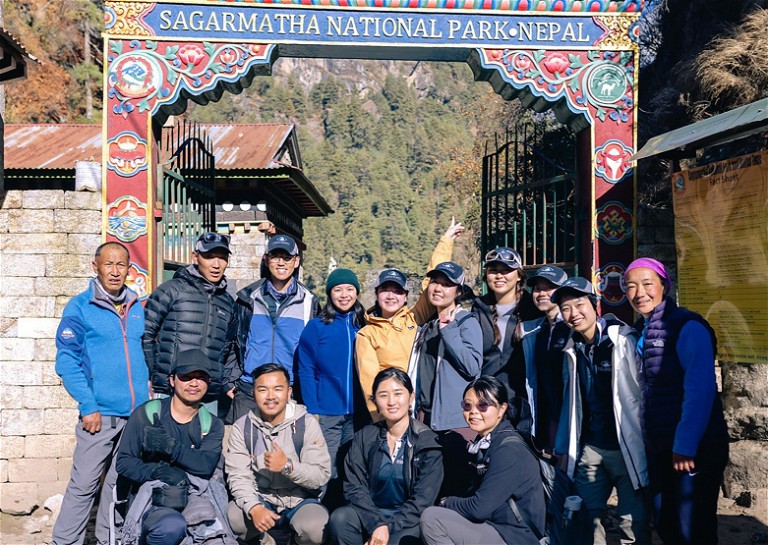mifeature
Clinic in the Clouds

Bridging Gaps in Eye Care
Eye testing at Khunde Hospital.
One of the greatest challenges in our working lives is finding a career that aligns with our core values. For many health professionals, a driving factor is a deep-seated desire to make a positive impact on the lives of others. In this article, Judy Nam shares her experiences working with the Centre for Eye Health and Eyes4Everest – two organisations in vastly different worlds, both dedicated to bridging the gap in eye care for vulnerable communities.
CENTRE FOR EYE HEALTH
I initially started working at the Centre for Eye Health (CFEH, a subsidiary of Guide Dogs NSW/ACT) as a student research assistant, but it was CFEH’s vision to reduce preventable blindness in our community that resonated with me and inspired me to join the team as a clinician once I become a qualified optometrist.
The focus of CFEH is to provide eye imaging, diagnostic, and management services to those most in need. As a team, we ensure that individuals who are unable to afford private eye care, or who are facing challenges in accessibility due to geographical or cultural barriers, can receive appropriate and timely care.
All diagnostic and management services are provided, with no out-of-pocket expense to patients who are most vulnerable in our community. CFEH developed a collaborative care Glaucoma Management Clinic in partnership with Prince of Wales Hospital Ophthalmology, where those with suspected or diagnosed glaucoma can be assessed by highly trained optometrists, and (where appropriate) be reviewed by a consultant ophthalmologist.
We also work within Westmead Hospital’s C-Eye-C program. This is a collaborative care model for chronic eye-diseases, such as glaucoma and diabetic retinopathy, where care of patients is shared between the public hospital and optometrists. The aim is to prevent avoidable vision loss by ensuring appropriate care is accessible in a timely manner.
The most rewarding aspect of being involved in both of these programs is witnessing the transformative impact of preserving vision in people of our community.
EYES4EVEREST
Eyes4Everest (E4E) is an initiative founded by Sydney optometrist, Shaun Chang. During a trek in the Himalayas in 2013, he observed that the people in remote regions of Sagarmatha (Everest) National Park had limited access to both general health care and eye care. Recognising the unique challenges faced by these villagers, Shaun has dedicated the past decade to providing eye care to the Himalayan communities.
When I saw that E4E was seeking a volunteer optometrist to join its 2023 expedition, I jumped at the opportunity.
My journey as a volunteer optometrist started with mixed emotions of excitement and nervousness. As we were welcomed by the locals, any apprehension I had quickly dissolved thanks to their warmth and hospitality. The Sherpa guides and porters treated us like family, and very quickly our group of volunteers became a team, united by our shared enthusiasm for the eye care services we were there to provide.
TREKKING TO KHUNDE HOSPITAL
After a few days of hiking through Sagarmatha National Park, we arrived at Khunde Hospital.
Khunde Hospital is located in Kunde village, which sits 3,840 m above sea level. It was built in 1966 by Sir Edmund Hillary at the request of the Sherpa community. Funded by the Sir Edmund Hillary Foundation in Canada since 1977, it is managed under the constitution of the Himalayan Trust Nepal.
We arrived in time to witness the opening ceremony of the hospital’s Eye Clinic – a facility only made possible by Shaun’s momentous dedication and effort over the past 10 years in collaboration with the Himalayan Trust Nepal.
There was a long line of people of all ages waiting for their eye tests, with some having walked hours to see us. We held eye camps at Khunde Hospital and at a health post in Pangboche, another village at an altitude of almost 4,000 m, examining a total of 275 patients.
The most common problems were dry eyes, uncorrected refractive error, and cataracts, but we were also able to assist a mountaineer with a rope injury to his eye. It was immensely rewarding being able to make such a meaningful difference in the lives of the villagers.
After days of eye testing, we also successfully trekked to reach Everest Base Camp and were able to take in the incredible natural beauty of Nepal and appreciate the generosity of spirit seen in the Sherpa community.

Eye testing at Khunde Hospital.

Community members line up outside the Khunde Hospital.
A CALL TO ACTION
This inspiring experience has given me a renewed sense of appreciation of how fortunate many people are in Australia to have easier access to eye care. It has also strengthened my resolve to work towards greater equity, so that our most financially, geographically, and medically vulnerable communities don’t have barriers to accessing timely and appropriate care. Such barriers put them at a higher risk for vision loss from treatable conditions.
The development of new referral pathways, as well as collaborative care and telehealth initiatives, all bring the potential to address existing inequities, and these are areas I look forward to exploring further through my work at the Centre for Eye Health.
I also hope to return to Nepal again soon. As an admirer of the work Shaun has done through this program, I would encourage anyone able, who shares our enthusiasm for making a positive impact on the lives of others, to volunteer for future trips. Committing to aid such an amazing cause is not a decision you will ever regret making.
“My journey as a volunteer optometrist started with mixed emotions of excitement and nervousness”

The Eyes4Everest team trekking through Sagarmatha National Park, Nepal.

“ It’s Up to Me ”
WRITER Shaun Chang
Shaun Chang (left), founder of Eyes4Everest with Pemba Sherpa, chairman of the Himalayan Trust Nepal, exchanging signed copies of the Memorandum of Understanding documenting each organisation's responsibilities regarding the provision of primary eye care in the Everest region.
In February 2013, I visited the Khunde Hospital following an unsuccessful trek in the Sagarmatha National Park. The doctors and hospital assistant gave me a tour of the hospital. Upon learning that I was an optometrist, they asked me what I could do for uncorrected refractive errors.
The hospital had an old Nikon vertometer, three bags of donated glasses, and a trial lens set from 1966. The lenses did not come with labels, and most were not in the box. I later learned from Dr John Heyden, a former volunteer GP stationed at the hospital, that the best they could do for patients with uncorrected refractive errors was to go through the bag of donated glasses and find a pair that provided the best vision.
I taught the doctors how to use the vertometer that cold afternoon. Our first mission was to return all the trial lenses to their appropriate slot. Upon completion, the hospital manager discovered that a -1.75D lens improved his distance vision significantly. I left knowing I had made a difference, but more work needed to be done.
After a few unsuccessful appeals to help the Khunde Hospital, my colleague, optometrist Dr Carina Trinh, helped me realise it was up to me to find a solution. And so our first team of three optometrists and one pharmacist travelled to the Khunde Hospital for our first eye camp in 2014. One of the optometrists got sick, so it was up to two optometrists to see 152 patients over two and a half days. A total of 32 pairs of glasses were prescribed. Our examinations involved refraction, binocular vision, and ocular health. Given our limited resources, it was little more than a visual screening and very tiring work. I was proud of our efforts, but patients were still waiting outside. Some had travelled three or four hours from their villages to see us and had to walk home in the dark. We left the hospital exhausted and heartbroken.
Stories from the 2014 trip brought us more volunteers in subsequent years. We decided to walk to the villagers rather than have them walk to us. Our equipment was limited to portable devices that had relatively good battery life. Occasionally, we would hear about a person who was so visually impaired that we had to examine them in their own homes.
Most of the time, we could identify the ocular condition affecting a patient’s vision. We could make and deliver prescription spectacles, provide ophthalmic eye drops for anterior eye conditions, and/or write a referral letter to an ophthalmologist if we identified cataracts or other UV-related damage. We wanted to educate patients about their ocular condition so that it would never limit their ability to travel to an ophthalmologist.
Eye camps organised by the Tilganga Institute of Ophthalmology (formerly the Tilganga Eye Centre) in Kathmandu, or the Visiting Ophthalmologists’ Scheme (VOS), run on a two-year basis between the Khunde Hospital and the Lukla Hospital, a Swiss funded hospital. We would pass on the patient’s contact details, so they could be contacted about cataract extraction surgery. Post-operative care was limited to one week, so complications following surgery were not uncommon.
As mentioned, some patients could not access eye care because they were confined to their homes or remote villages. Some did not want to access eye care at all.
I remember a case of ocular albinism in a Sherpa girl in 2015. Ideally, we would have provided her with prescription sunglasses and referred her for low vision management. We could not do the latter, and I am sad to say we never saw her again. The family decided in later years to isolate themselves from the community. Sherpas are devoted to Buddhism and consider medical ailments to be the work of evil spirits. If prayers from the lamas and Western medicine do not work, many consider isolation a sensible option.
As the years of eye testing went on, we were joined by Nepalese optometrists and health assistants of Sherpa ethnicity. They had the cultural background to reverse outdated thinking and were passionate about improving their people’s lives. Some of them became our good friends.
During the COVID pandemic, sending Australian and New Zealand volunteers was impossible, so it was up to our Nepalese team to continue our work. However, we agreed that a collaborative approach was the best eye care for the mountain communities.
In 2023, 70 years after the first ascent of Mt Everest, we opened a dedicated eye clinic within an existing room at Khunde Hospital. The clinic is equipped with an autolensometer, digital letter chart, slit lamp, and refraction and binocular vision equipment. The next challenge is to determine the best way to staff the clinic, so it can continue to provide reputable primary eye care. I am reminded that when the hospital opened in 1966, volunteer Kiwi doctors took care of it. The Sherpas at the hospital were assistants but slowly built up their own experience from working there. One of these assistants was Kamitemba Sherpa, who later received a scholarship to study medicine in Fiji. He returned to the hospital as a qualified Sherpa doctor.
I don’t know if this will be the story for our eye clinic in the cloud. However, I am confident that the solution will find itself.
Shaun Chang graduated from University of NSW in 2008 and is the owner of Eyes2Learn, a behavioural optometry practice in Newcastle in the Hunter Region of New South Wales. He is a Fellow of the Australasian College of Behavioural Optometrists and holds a postgraduate ocular therapeutics degree from the University of Melbourne. He founded Eyes4Everest in 2014.
Judy Nam Bsc, MClinOptom is a clinician researcher at the Centre for Eye Health with interests in improving early diagnosis and using imaging technologies to develop enhanced health management systems. She is the chair of Optometry NSW/ACT Early Career Optometrists committee, where she advocates for young optometrists, ensuring the profession continues to be an integral part of the healthcare community.